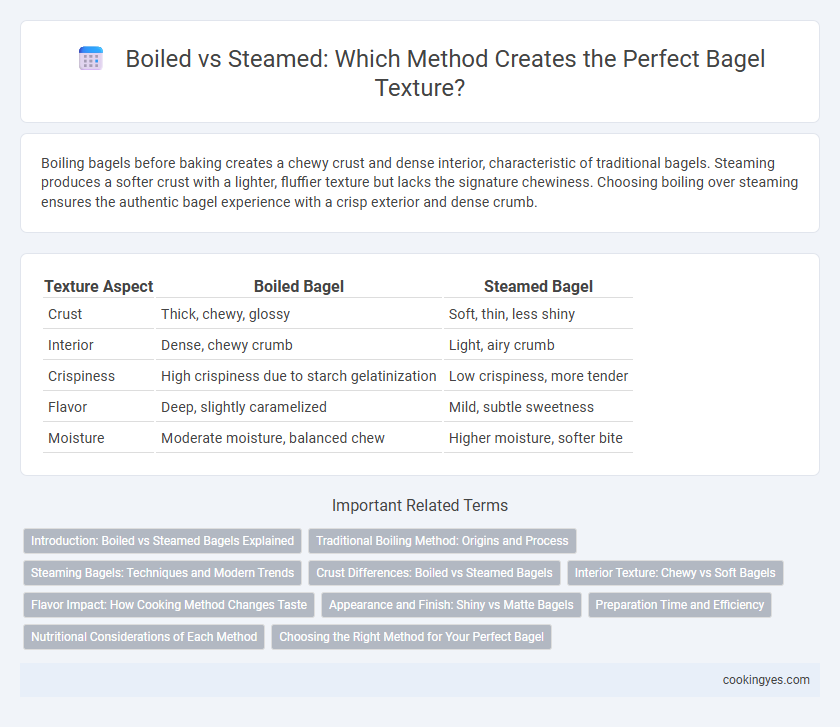Boiling bagels before baking creates a chewy crust and dense interior, characteristic of traditional bagels. Steaming produces a softer crust with a lighter, fluffier texture but lacks the signature chewiness. Choosing boiling over steaming ensures the authentic bagel experience with a crisp exterior and dense crumb.
Table of Comparison
| Texture Aspect | Boiled Bagel | Steamed Bagel |
|---|---|---|
| Crust | Thick, chewy, glossy | Soft, thin, less shiny |
| Interior | Dense, chewy crumb | Light, airy crumb |
| Crispiness | High crispiness due to starch gelatinization | Low crispiness, more tender |
| Flavor | Deep, slightly caramelized | Mild, subtle sweetness |
| Moisture | Moderate moisture, balanced chew | Higher moisture, softer bite |
Introduction: Boiled vs Steamed Bagels Explained
Boiled bagels develop a dense, chewy crust with a characteristic glossy finish due to the starch gelatinization in boiling water, which locks in moisture and creates a distinct texture. Steamed bagels tend to have a softer, less chewy exterior with a lighter texture because steam cooking retains more moisture without forming a crust. Understanding these differences helps bakers choose the ideal method to achieve the preferred balance between chewiness and softness in bagels.
Traditional Boiling Method: Origins and Process
The traditional boiling method for bagels, originating from Eastern European Jewish communities, involves briefly boiling the dough in water before baking to achieve a dense and chewy texture unique to authentic bagels. This process gelatinizes the starch on the bagel's surface, creating a shiny, crisp crust that contrasts with its soft interior. Steaming lacks this starch gelatinization step, resulting in a softer, less chewy bagel that deviates from the classic New York-style texture achieved through boiling.
Steaming Bagels: Techniques and Modern Trends
Steaming bagels creates a softer, less chewy crust compared to the traditional boiling method, appealing to those who prefer a delicate texture. Modern bakeries experiment with various steaming techniques, such as using specialized steam ovens or incorporating flavored steam infusions to enhance aroma and taste. This trend emphasizes a light, fluffy interior while retaining the characteristic bagel shape, catering to evolving consumer preferences for artisanal and innovative bread products.
Crust Differences: Boiled vs Steamed Bagels
Boiled bagels develop a thick, chewy crust with a glossy finish due to the starches gelatinizing on the surface during boiling. Steamed bagels feature a softer, less chewy crust with a tender texture, as the steam creates a moist environment that prevents crust hardening. The boiling process results in a distinctive, crispier exterior, while steaming produces a more delicate and fluffy crust.
Interior Texture: Chewy vs Soft Bagels
Boiled bagels develop a dense, chewy interior due to starch gelatinization during the boiling process, which creates a firm crumb and classic bite. Steamed bagels result in a softer, more tender interior texture as the gentler steam heat prevents crust formation, allowing the dough to remain light and airy inside. Texture preferences depend on the desired chewiness, with boiling producing traditional chew and steaming yielding softer, fluffier bagels.
Flavor Impact: How Cooking Method Changes Taste
Boiling bagels creates a denser crust with a slightly tangy flavor due to the Maillard reaction from the water's minerals, enhancing the traditional taste. Steaming results in a softer, more pillowy texture with a subtle sweetness that highlights the dough's natural flavors. The choice between boiling and steaming dramatically alters the bagel's mouthfeel and flavor profile, catering to distinct preferences.
Appearance and Finish: Shiny vs Matte Bagels
Boiling bagels creates a shiny, firm crust due to the starches gelatinizing on the surface, resulting in a traditional glossy finish that contrasts with the matte appearance of steamed bagels. Steamed bagels produce a softer, less dense crust with a muted, matte look because the surface does not undergo the same gelatinization process. Texture-wise, boiled bagels have a chewier bite and a distinct crispness, while steamed bagels are softer and pillowy with a more uniform matte finish.
Preparation Time and Efficiency
Boiling bagels typically requires 1-2 minutes per side, ensuring a dense and chewy crust, but it can be time-consuming for large batches due to frequent water replenishment. Steaming bagels, on the other hand, is faster, often taking only 5-7 minutes total, and produces a softer, less crusty texture while improving preparation efficiency in commercial settings. Choosing between boiling and steaming depends on desired texture and production speed, with steaming offering a more streamlined process for high-volume bagel makers.
Nutritional Considerations of Each Method
Boiling bagels gelatinizes the starch on the surface, creating a dense crust while slightly reducing water-soluble vitamins due to nutrient loss in the water. Steaming preserves more of these water-soluble nutrients but results in a softer, less chewy texture. Choosing between boiling and steaming affects both the bagel's texture and its retention of vitamins such as B-complex and vitamin C.
Choosing the Right Method for Your Perfect Bagel
Boiling bagels creates a dense, chewy crust with a characteristic shine, ideal for traditional New York-style bagels. Steaming produces a softer crust and lighter texture, often preferred for sweeter or flavored bagels. Selecting between boiled or steamed methods depends on your desired crust firmness and interior chewiness to achieve the perfect bagel texture.
Boiled vs Steamed for Bagel Texture Infographic

 cookingyes.com
cookingyes.com